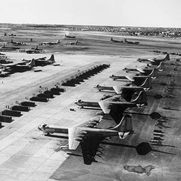Steven Schwartz
January, 2012
View the full Global Security Newswire article:
Unaccountable: Exploring the Lack of Budgetary Transparency for US Nuclear Security Spending

A fleet of B-36 Peacemaker bombers and 16-person crews at Carswell Air Force Base, Texas, in 1955, US National Archives
Today—as has been the case for more than sixty years—no one in the federal government can say with certainty how much money is being spent on nuclear weapons and weapons-related programs. This is because there is no comprehensive budget or budgetary line item tracking all relevant programs and costs across agencies and over time. The problem is especially acute for the Department of Defense, where most nuclear security dollars are spent.
But with future federal spending more likely to decrease than to increase, it is essential to understand where taxpayer dollars are going, and why. An incomplete or erroneous understanding of the full costs of nuclear weapons and weapons-related programs impedes accountability and will lead—as it has repeatedly in the past—to poor decision making and wasteful spending.
This article explains the history behind the extraordinary lack of transparency for U.S. nuclear weapons and weapons-related programs, starting with their origin during World War II. It also describes efforts by some officials to produce a more accurate accounting and assesses the impact of the lack of such information on the ultimate size and composition of the nuclear stockpile during the Cold War.
The Obama administration’s intention to spend more than $200 billion updating the nuclear weapons production complex and on new or modernized nuclear delivery systems (strategic bombers, ballistic missiles, and submarines) make it imperative to fully understand both annual and cumulative nuclear security spending. To resolve this longstanding problem, Congress should require the executive branch to prepare an annual, comprehensive budget for all federal spending on nuclear weapons and weapons-related programs documenting expenditures for the prior, current, and next fiscal year.
Such an accounting should be unclassified to the greatest extent possible, with a classified annex only for especially sensitive programs. Once fully implemented, this approach would provide a significantly better appreciation of the costs to policy makers and the public alike (enabling more informed debates), allow for accurate cost-benefit analyses, and permit more accurate forecasting of savings from programmatic changes.
